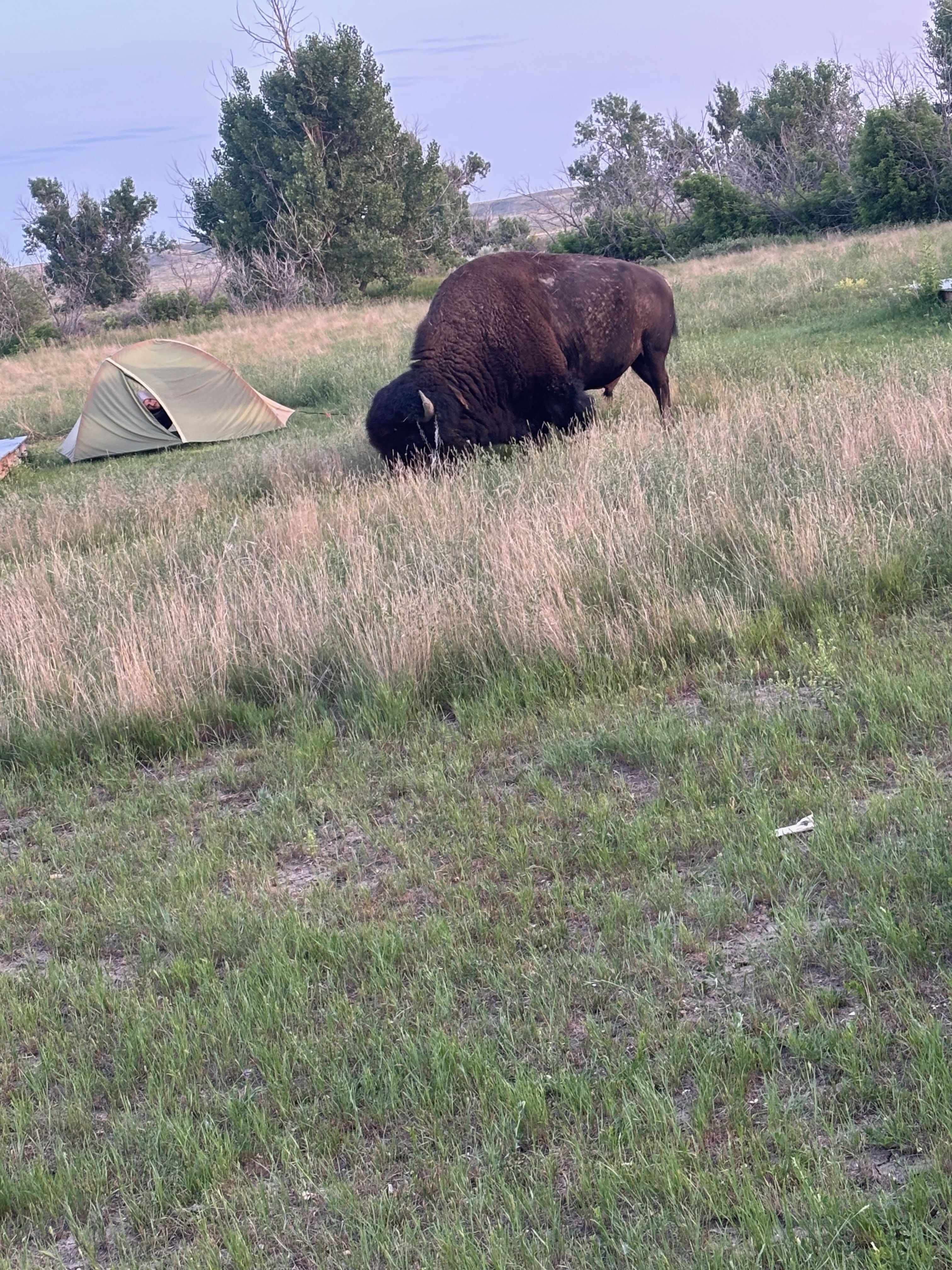
When I first heard that my crew was going to have two hitches at Sun Prairie, part of American Prairie Reserve, my first reaction was excitement about the prospect of seeing bison. I’m happy to say that this excitement proved to be justified, as I saw the first bison of my life within hours of arriving at our campsite. The bison sightings only grew more spectacular as our hitches at Sun Prairie went on, the most memorable of which was waking up to the sound of a full-grown male bison munching on grass mere feet away from my tent door. Living among the bison at Sun Prairie is an experience that I will truly cherish for the rest of my life.
Aside from the natural beauty and intrigue of these enormous ungulates, the reverence I feel for bison lies in their history and ecological importance. It’s almost unfathomable to consider that an estimated 30–60 million bison once roamed North America. This animal, which defined the Great Plains and was fundamental to the lifestyles and cultures of tribes residing in the region, was reduced to just a few hundred individuals by the late 1880s. The near eradication of the American bison left a cultural and ecological void in the prairie. As part of their ultimate mission of restoring 3.2 million acres of land to a fully functioning shortgrass prairie ecosystem, American Prairie (AP) is helping to fill the bison-less void in a large swath of the Montana plains.
Another animal relevant to our time at Sun Prairie and marked by its historical significance and ecological impact is the North American beaver. It’s easy to forget that the most important driver of European westward expansion in North America during the late eighteenth and early nineteenth centuries was a dam-building semiaquatic rodent. High demand for beaver pelts meant the trapping and extirpation of beavers in nearly every river and tributary of areas such as present-day Montana. Similar to the detrimental impact bison hunting had on Great Plains ecosystems, the decimation of beaver populations has been calamitous for the health of our water systems. The legacy of the fur trade, coupled with misguided beaver and land management practices, can still be seen in countless streams and creeks across North America.
I tried to keep this history and American Prairie's (AP) ambitious mission in the back of my mind as my crew worked on Telegraph Creek at Sun Prairie. Telegraph Creek is an intermittent stream that flows about 16 miles through AP’s Blue Ridge and Sun Prairie Units. It faces similar challenges to many other streams we will be working on this summer, namely: incision (erosion of stream banks resulting in disconnection to floodplain), lack of sinuosity (curviness needed for dispersal of water's energy), a lack of woody riparian vegetation due to a low water table and disconnected floodplain, and a lack of beaver which results in a self-reinforcing degraded system. To address these challenges, we used a familiar repertoire of Low Tech Process-Based Restoration (LTPBR) techniques, aimed primarily at “slowing down” and “spreading out” water while aggrading sediment behind structures to bring the stream bed closer to its floodplain. What I appreciated most about our LTPBR work on Telegraph Creek is that the main objectives are to:
1. Improve the quality and quantity of riparian/wetland habitat.
2. Create a habitat suitable for beavers to eventually recolonize the stream and do the restoration work for us.
Having joined MCC largely because of my interest in beavers and beaver mimicry, partnering with an organization like American Prairie that fully appreciates the animal and desires its recolonization was an incredible experience. The Telegraph Creek restoration plan embodies ecological humility and represents a distinct departure from the harmful legacy left by the fur trade. It was an honor to play a small part in this long-term restoration project, and I believe that Telegraph Creek will one day return to a state suitable for beavers to work their ecosystem engineering in, riparian and wetland species to thrive in, and prairie species to find water and refuge in. The prairie is a place where you feel a heightened sense of awareness of the rich history that surrounds you, and I’m grateful that my crew had the chance to make a positive contribution to the history of Telegraph Creek's revitalization.

![[Image Description: Two MCC members taking a brief break; one is sitting on a rock, the other is standing nearby. They are both in their uniforms, looking out at the expansive, mountain view surrounding them.]](https://cdn.firespring.com/images/c3f85e97-43a9-4810-8081-e8e6338173d0.jpeg)



